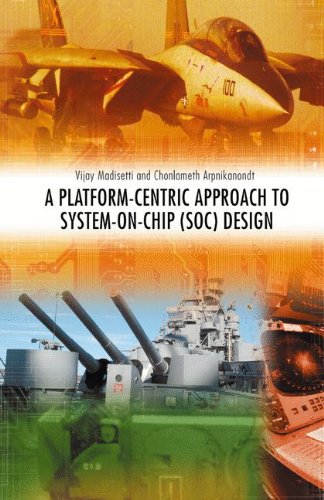Product desciption
A Platform Centric Approach To System On Chip Soc Design 1st Edition Vijay Madisetti by Vijay Madisetti, Chonlameth Arpnikanondt 9781441936691, 1441936696 instant download after payment.
The platform-centric SoC method is aimed at the design of today’s SoC systems with emphasis on real-time, embedded systems. The approach provides a guideline and an SoC design environment that promotes an integration of state-of-the-art tools and techniques necessary for the development of the systems. It renders a new and better perspective towards co-design approaches, while also raising a level of design abstraction. Because the configurable platform objects are designed off-cycle, they contribute to a general improvement in development time. By incorporating their usage, the overall method strikes a balance between total design flexibility and minimal time-to-market.
In Chapter 1, challenges in the co-design of SoCs are introduced. The chapter briefly describes the technical challenges facing system developers and introduces a proposed solution to the problem. The remainder of this book presents a more thorough examination on the problem and the proposed approach.
Chapter 2 describes the proposed platform-centric SoC design method in detail. It illustrates the design flow and discusses each main step in the design process. Definition of a platform as originally defined by Sabbagh [96], as well as the platform-based and platform-centric design approaches, are presented. The chapter concludes by comparing the proposed approach with previous related work.
Chapter 3 lays out the technological background for the proposed SoC design method. Whereas the platform technology is discussed in Chapter 2, this chapter gives an overview of the other two fundamental technologies: the Unified Modeling Language (UML) and the Extensible Markup Language (XML). The chapter begins with an introduction to UML as a modeling tool very well perceived within the software engineering community. It is followed by a discussion on an attempt by the Object Management Group (OMG) to empower UML for the development of real-time embedded software – an effort which will eventually culminate in a design framework known as the UML Profile for Schedulability, Performance, and Time Specification [29]. Thereafter, an overview of XML and a few other related internet technologies ensue.
Chapter 4 outlines the structure of the library of platform objects (LPO), as well as furnishes a comprehensive guideline and requirements specification that a platform object must possess in order to be scalable and compatible with the proposed approach. Essential elements for each platform object, e.g. architecture blueprint, XML-based self-described modules, platform managing tool, etc., are also discussed in detail.
Chapter 5 provides a detailed treatment of UML extensions for the development of real-time embedded systems. The chapter starts with a layout of the Co-design Modeling Framework (CMF) hierarchy that encompasses five other sub-profiles – the generic utility profile (PCUprofile), the Exception Modeling profile (EMprofile), the Interrupt Modeling profile (IMprofile), the Synthesizable Hardware Description Language profile (SHDLprofile), and the Architecture Blueprint profile (ABprofile). Each of these profiles furnishes a design framework that is specifically tailored for the proposed approach, and may be able to meet with the challenges posed by the design and test of real-time embedded SoC-based systems. The chapter, then, proceeds to discuss the domain concept for each sub-profile, followed by the description of the corresponding stereotypes.
Chapter 6 applies the platform-centric SoC design method, using the CMF profile in UML, to the development of a simplified digital camera system so as to demonstrate the use and the robustness of the proposed approach. Specifically, the NiOS development board is used to mimic the digital camera system where raw image data are read from a charge-coupled device (CCD), and then JPEG encoded and stored into memory. The chapter begins with an overview of the Altera’s NiOS system, followed by the actual system development process that explicitly demonstrates the use of the proposed approach. A quantitative evaluation is then presented that compares the development cost of the proposed platform-centric SoC design method against some alternative approaches using cost estimation models and tools.
Chapter 7 concludes the book with a summary and a discussion of future directions for this effort on platform-based design.


